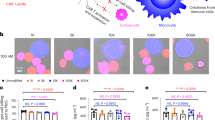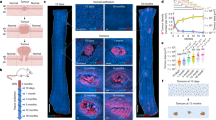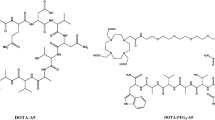Abstract
Polyethylene glycol (PEG) modification of a chimeric Fab' fragment (F9) of A5B7 (alpha-CEA), using an improved coupling method, increases its specificity for subcutaneous LS174T tumours. PEGylation increased the area under the concentration-time curve (AUC0-144) in all tissues but there were significant differences (variance ratio test, F = 27.95, P < 0.001) between the proportional increases in AUC0-144, with the tumour showing the greatest increase. The increase in AUCtumour from F9 to PEG-F9 was similar to the reported increase from Fab' to F(ab')2 while the increase in AUCblood by PEGylation of F9 was only 21% of the reported increase from Fab' to whole IgG. A two sample t-test showed no significant differences between maximal tumour/tissue ratios for PEG-F9 and F9 while the tumour/tissue ratios for PEG-F9 remained high over a longer period, with tumour levels at least double those for F9. PEG-F9 emerges as a new generation antibody with potential advantages for both radioimmunotherapy and tumour imaging. Since there was a reduction in antigen binding, optimisation of PEGylation might further improve tumour specificity. The latter resulted from complex effects on both the entry into and exit rates from tumour and normal tissues in a tissue-specific fashion.
This is a preview of subscription content, access via your institution
Access options
Subscribe to this journal
Receive 24 print issues and online access
$259.00 per year
only $10.79 per issue
Buy this article
- Purchase on SpringerLink
- Instant access to full article PDF
Prices may be subject to local taxes which are calculated during checkout
Similar content being viewed by others
Author information
Authors and Affiliations
Rights and permissions
About this article
Cite this article
Delgado, C., Pedley, R., Herraez, A. et al. Enhanced tumour specificity of an anti-carcinoembrionic antigen Fab' fragment by poly(ethylene glycol) (PEG) modification. Br J Cancer 73, 175–182 (1996). https://doi.org/10.1038/bjc.1996.32
Issue date:
DOI: https://doi.org/10.1038/bjc.1996.32
This article is cited by
-
Microgel applications and commercial considerations
Colloid and Polymer Science (2011)
-
Efficient inhibition of EGFR signalling and of tumour growth by antagonistic anti-EGFR Nanobodies
Cancer Immunology, Immunotherapy (2007)
-
Inhibition of Henipavirus fusion and infection by heptad-derived peptides of the Nipah virus fusion glycoprotein
Virology Journal (2005)
-
Polymerizable Fab′ antibody fragments for targeting of anticancer drugs
Nature Biotechnology (1999)
-
Pharmacokinetics of Monoclonal Antibodies
Clinical Immunotherapeutics (1996)



